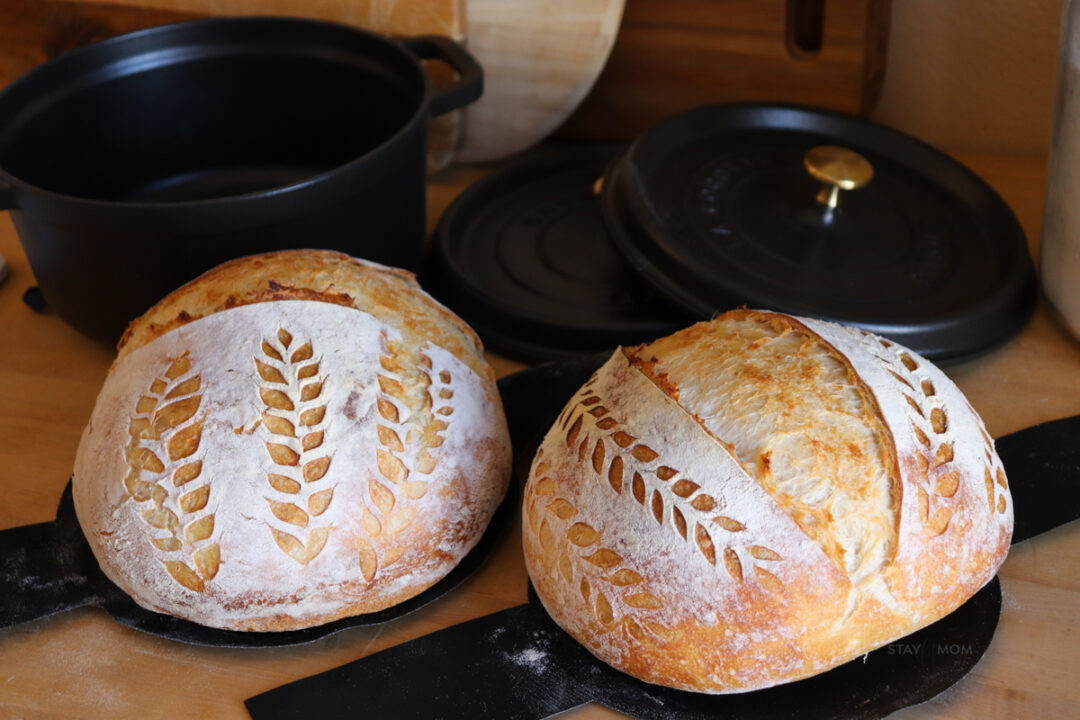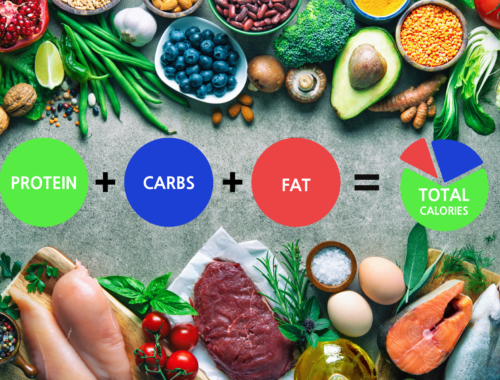After over 4 years of learning and making my own sourdough bread, I’m ready to teach you my recipe. I’ve used a few different recipes over the years and have learned what works best for me, my climate, and my schedule. Please keep in mind that mastering sourdough takes lots of patience and practice. While the amount of steps and time can seem overwhelming, I assure you it’s very flexible and so rewarding to learn. It will become second nature to you in no time at all.
What is Sourdough?
Sourdough is slow fermented bread. Unlike traditional bread that uses a bakers yeast, it uses a ‘starter’ – a live culture of flour, water, and naturally occurring bacteria and yeast, that makes the bread rise.
Is Sourdough Bread Better For You?
- The slow fermentation of sourdough bread gives us a head start on digestion, which for some with digestive issues has been shown to make it much more tolerable.
- Sourdough acts as a prebiotic, feeding the good bacteria in your gut and intestines.
- Sourdough bread contains much less gluten than regular yeasted bread due to the slow fermentation process, but it does not remove all gluten and is not gluten free.
This post contains affiliate links. If you purchase something from these links, we could earn a small commission. This would be at no additional cost to you.

Where Can I get a Starter to Make Sourdough Bread?
You’ll need your own starter to make this sourdough bread. You can purchase sourdough starter online, get some from a friend, or make your own. Keep in mind making your own will take several weeks and can be very frustrating for beginners, which is why I don’t recommend it. I highly suggest getting some locally from a friend, a neighborhood Facebook group, or just ordering it online. Once you do so, you’ll need to feed it regularly to keep it alive. Everything you need to know about Feeding and Maintaining a Sourdough Starter is here.

What Supplies Do I Need to Make Sourdough?
Must Haves For Making Sourdough Bread:
- Your own starter
- Bread Flour – I use King Arthur’s unbleached bread flour from my local grocery stores. They sell an organic option online if you prefer organic.
- Salt
- Digital Kitchen Scale – I can’t recommend this one enough. It has a nice big screen that you can see even with a large bowl or plate on it.
- Mixing Bowl – My favorite bowl is 9″ in diameter and about 3.5″ deep. It’s from Target but no longer available. I found a few similar ones that you might like on Amazon. This one or this one both look like great options. I wouldn’t go much bigger than 9″ in diameter because the shower caps only stretch so far.
- 7″ Banneton Proofing Basket(s) – I like this size best, but anywhere from 7-9″ baskets will get the job done.
- Razor blade or Bread Lame for scoring your bread before baking.
- 4qt. or larger Dutch Oven(s) -I like baking 2 loaves at a time and these 4qt. dutch ovens fit perfectly together in my oven. I was recently gifted these beautiful 4qt. Staub Cocottes from Zwilling and I’m smitten with them. These will last my lifetime. For a more affordable option, check out these Lodge 4.5qt cast iron dutch ovens.
- Half Sheet Pan 13X18 – If you have an old one, just use that! This will just be going in on the bottom rack while cooking your loaves so the bottom doesn’t burn.
Additional Supplies I love for Making Sourdough Bread:
- Bench Scraper
- Disposable Shower Caps – I use these to cover my dough and they’re amazing. You can reuse them multiple times.
- Baking Mats – These are wonderful, but you may need to cut them down to size like I did.
- Danish Dough Hook
- Bread Bow Knife
You can buy a lot of these things in bundles. Here is my full sourdough shop on Amazon will a few bundle options I think would be great.

How to Make Sourdough Bread: Step by Step Guide
Step #1: Make your Levain
In a large jar combine:
- 30 g bubbly active starter
- 130 g bread flour
- 130 g water (room temp)
This will sit our your counter and ferment 8 -12 hours. (I tend to do this first thing the morning so I can begin the next step around 5 or 6 pm.)

Step #2: Mix the Dough
In a mixing bowl (or your electric mixer) combine:
- 662 g water (room temp)
- the levain (about 290 g total)
- 1037 g bread flour
I like to combine the water and levain first with my dough hook. Then slowly add your flour a couple cups at a time. Once all the flour had been added you can knead by hand 5-10 minutes, or put it in the electric mixer with the dough hook attachment for 10 minutes. Once done, cover with a shower cap or large plate and let is rest on the counter, or “autolyse”, for 15-30 minutes.
TIP: Wet your hand occasionally with cold water to prevent so much sticking. Don’t fret if your dough is stuck to your hand, keep kneading and just scrape it off as best you can when done.

Step #3 Add the Salt
In a small bowl combine:
- 19 g salt
- 1 tablespoon water
Pour this into your dough and knead an additional 5-10 minutes by hand or in your electric mixer. Cover with your shower cap or plate and let it rest 45 – 60 minutes.

Step #4 Stretch & Folds
Wet your hands and gently grab one side of the dough and pull it up, stretching it out as much as you can without tearing it, and fold it over. Turn your bowl to stretch and fold all four sides of the dough, as if it were a square. Cover and let it rest 45- 60 minutes. Repeat this stretch and fold series 3 more times, for a total of 4 stretch and folds.
You’ll notice your dough start to transform with every series of stretch and folds. These stretch and folds are an important step used to strengthen the gluten in your sourdough.

At this point you’ve been working with your dough 3-4 hours. If you’re on the same schedule as me, it’s almost 10:00pm. If you only got 3 stretch and folds in, no big deal, move on the the next step.

Step #5 Bulk Ferment
After your last series of stretch and folds it’s time to cover the dough and let it bulk rise. This might be the trickiest step for beginners. You’re looking for your dough to almost double in size, and appear much less dense. You’ll learn with practice to recognize when the dough is ready. If left sitting on the counter, in a home that is around 68-70 degrees, this bulk rise typically takes 8-10 hours. If your home is cooler, it will take longer, and if your home is warmer, it will rise quicker. Another way you can manipulate your schedule some is to let it bulk rise in the fridge for up to 24 hours. You’ll just want to let it come back to room temp before moving on to step 6. Here’s a look at what I typically do:
- 10:00pm – Put the dough in the fridge overnight.
- 7:00am – Pull the dough out and place on the counter to come to room temp and finish rising.
- 12:00pm – My dough is now at room temp and appears to have doubled in size. Time to move on to step 6.
I usually do it this way on weekdays because I have school drop off first thing in the morning, I go to the gym, and often run errands before going home. If it were a weekend and I knew I had time in the morning to I would instead do this:
- 10:00pm – Put the dough in the fridge.
- 2:00am – Pull the dough out and place on the counter to come to room temp and finish rising.
- 7:00am – My dough is now at room temp and appears to have doubled in size. Time to move on to step 6.

Step #6 Divide , Laminate, & Shape
Divide – Remove the dough and place on a clean, dry surface(Do not use flour). Divide the dough into two equal loaves. You can use a food scale here if you want to be precise.

Laminate – Begin stretching one of the loaves out on your counter top, being careful not to rip it apart. I like to place mine in the center of the counter, and section by section, lift and and gently shake the dough to stretch it out.

If you want to incorporate any inclusions (cheese & jalapeños, cinnamon & sugar, etc.) This is when you would do so! Sprinkle your inclusions on the dough when stretched out. See my sourdough highlight reel on my IG for more ideas!

Shape -Begin folding the dough up. You can fold in each side and roll it up (I do it this way if using add-ins) or fold each side into the center going around and around until you have formed a loaf. Take your loaf and build tension by pushing and pulling the loaf across the counter. Once you have a nice, tight, round loaf repeat with the second. Let them both rest on the counter for 10-20 minutes before repeating the lamination process(this is called the bench rest). Keep in mind that the second time around the dough will remember it’s shape and won’t stretch as far as the first time. This is why I like to incorporate my inclusions during the first lamination.


Step #7 Final Proof
After the final shape flip your dough upside down and gently drop in your floured banneton baskets. Cover and let proof for about 1 – 1.5 hours. In warmer months I do closer to 1 hour, in cooler months I let them proof at least 1.5 hours. Again, you will learn to recognize when they’re fully proofed with practice.
At this point you could move on the the final step, but I prefer to bake them cold so I put mine in the fridge for 4-6 hours, or in the freezer for 1 hour. Which I do simply depends on my schedule that day.

Step #8 Score & Bake
Place the dutch oven(s) in the oven with the lids on and preheat to 500 degrees.
Remove your sourdough from the bannetons by covering each with a piece of parchment paper, or a baking mat, and fliping the basket upside down. Gently shake or tap the dough out of the basket.
Scoring the dough is one of my favorite parts of the whole process. Of course you can simply just slice your loaves across the top and be done with it, but I like to experiment with pretty designs. I gently wipe off any excess flour and use my bread lame to slice in my designs.
Gently drop your sourdough into your dutch oven pan(s) and place in the oven with the lid on. Add a half sheet pan to the bottom rack below the dutch ovens (on the rack below, not directly under the dutch ovens). Reduce heat to 450 degrees and bake for 20 minutes. Remove the lid(s) and bake an additional 20-25 minutes, depending on how toasted you prefer your sourdough.

7 Minute Deep Score Tip – Another trick I’ve learned is to take the dough out of the oven real quick after 7 minutes of baking to do the expansion score. This gives the smaller scored design time to expand and look pretty.

Eat & Enjoy!
I don’t know if there is anything better than freshly baked, warm sourdough.

I always let mine cool 30-60 minutes before slicing with a bow knife. This knife is so very sharp, but it makes for perfectly uniform slices.

How to Store Sourdough
- In the dutch oven with the lid just slightly cracked open.
- In a ziplock bag (Make sure to let it cool completely before sealing the bag).
- Double bagged in the freezer (Again let it cool completely before throwing in the freezer). I like to pre slice my whole loaf so I can take out 1 slice at a time and to toast.

Sourdough Inclusions
I’ll share a new post with inclusion ideas soon! For now see my sourdough highlight reel on my IG for the final more about this.

Sourdough Bread
Equipment
- 1-2 4qt. Dutch ovens
Ingredients
For the Levain
- 30 g active starter
- 130 g water room temp.
- 130 g bread flour
For the Dough
- 662 g water room temp
- 1037 g bread flour
- 19 g salt
- 1 tbsp water
Instructions
- In a large jar or bowl combine the levain ingredients well. Cover and let ferment 8-10 hours.
- In a large mixing bowl, or in your electric mixer, combine the 662g water and the active bubbly levain. Stir well.
- Slowly mix in the 1037g flour. Knead by hand 5-10 minutes, or put in the electric mixer with the dough hook attachment for 10 minutes.
- Cover and let rest 15-30 minutes.
- In a small bowl combine the salt and 1 tbls. of water. Add it to the dough and knead another 5-10 minutes. Cover and let it rest on the counter 45-60 minutes.
- Begin the first series of stretch and folds. Pull one side of the dough up out of the bowl to stretch and then fold over itself. Turn the bowl another 90 degrees and repeat until you've stretched and folded the dough four times. Cover and let it rest on the counter another 45-60 minutes. Repeat this series of stretch and folds 3 more times, for a total of 4.
- Cover and let it rise 8-10 hours at room temp (68-70 degrees) or in the fridge for up to 36 hours. The dough will almost double in size, and should appear less dense and very giggly. If fermenting in the fridge, let it come to room temperature before moving on to the next step.
- Divide the dough into 2. One loaf at a time stretch the dough out as much as it will allow without ripping (This is called lamination). Fold it back up to form a loaf. Push and pull the round loaf across the counter to build tension. Once you have a nice tight loaf set aside and repeat with the second loaf. Let both loaves rest on the counter, uncovered, for 10-20 minutes.
- Repeat the lamination process a second time. Keep in mind the bread will remember it's shape and wont stretch as well the second time around. If you want to add any inclusions (cheddar + jalapeños, cinnamon + sugar, etc.) do it during the first lamination and skip right to the next step.
- Flip the loaf upside-down and gently drop into your floured proofing baskets. Cover and let rise 1 – 1.5 hours.
- Once proofed, place in the fridge for 4-6 hours, or freezer for 1 hour. (You can technically bake them now, but I like to score and bake them cold)
- Preheat the oven to 500 degrees with the dutch oven(s) inside.
- Remove loaves from the banneton proofing baskets. You'll want to flip them onto a piece of parchment paper or bread mats. Score with a razor blade or bread lame.
- Gently drop into the preheated dutch ovens and cover with the lids. Place in the oven with a half sheet pan on the rack underneath (this will keep the bottoms from burning). Reduce the oven temp to 450 degrees and bake for 20 minutes.
- Remove the lids and bake an additional 20-25 minutes, depending on how toasted you like your bread.
- Let cool 30-60 minutes before slicing.
- Store in the cooled dutch ovens or in a ziplock bag. If placing in the freezer double bag.




10 Comments
I had tried so many recipes before finding this one and they never came out as beautiful as these. I get the perfect crumb and crust with a beautiful oven rise. I love using my kitchen aid for the first 2 steps it makes life easier and I think helps build the strength of the gluten more than hand kneading.
Jillian I’m so glad you have found success with my recipe!! This makes me so happy. Thank you so much for taking the time to share. I agree, using the kitchen aid is super helpful and works so nicely.
Thank you for this! One question – why do you prefer to bake your bread cold?
I mostly like to score it cold because it holds its shape better. And because it holds its shape better and the score design, it just turns out a little nicer.
Best recipe you will find! I have tried lots of different ones and played with different hydration levels and this just turns out perfect for me, every time! My arms get so tired kneading by hand so I love using my mixer. This, combined with the videos in your stories, should make it possible for ANYONE to make sourdough!
Hi Jess! Thanks so much for the review! I’m so glad you have found great success with the recipes and videos. And I agree, using the mixer is a nice break. Thanks again!
Hello
Your breads look amazing!
I’ve been making bread for the past 4 months and slowly getting a little knowledge. Although my breads are tasty and look nice, the dough always seems very soft and when I take out of the basket it flattens and when I cut any design it disappears. It does rise again in the oven. But never stays up firm and jelly like, before I bake. Any idea what I’m doing wrong please.
Hi Sandra! Sorry for a late response, I missed this one last week. I would suggest trying 2 things. Add a little more flour to your dough recipe (100 grams or so) and/or score the dough really cold. Refrigerate your dough 4-6 hours before scoring, or freeze 45-60 minutes. Another thing I’ve learned is really important for a good strong dough is a high protein flour or bread flour instead of all purpose. Hopefully these things help!
Got my first starter today from a friend. Nervous to be a begginer, but I’m giving it a shot! With the discard, can you gift some to someone else and still have some left for yourself and keep in the frig? Anxious to begin and ordered what you suggested as my tools!
Hi Robin! I’m so excited for you! Yes, each time you feed your starter you can gift the discard to others. Just put it in a new jar and feed it for them. Let them know to feed it the next day and they’re all set.